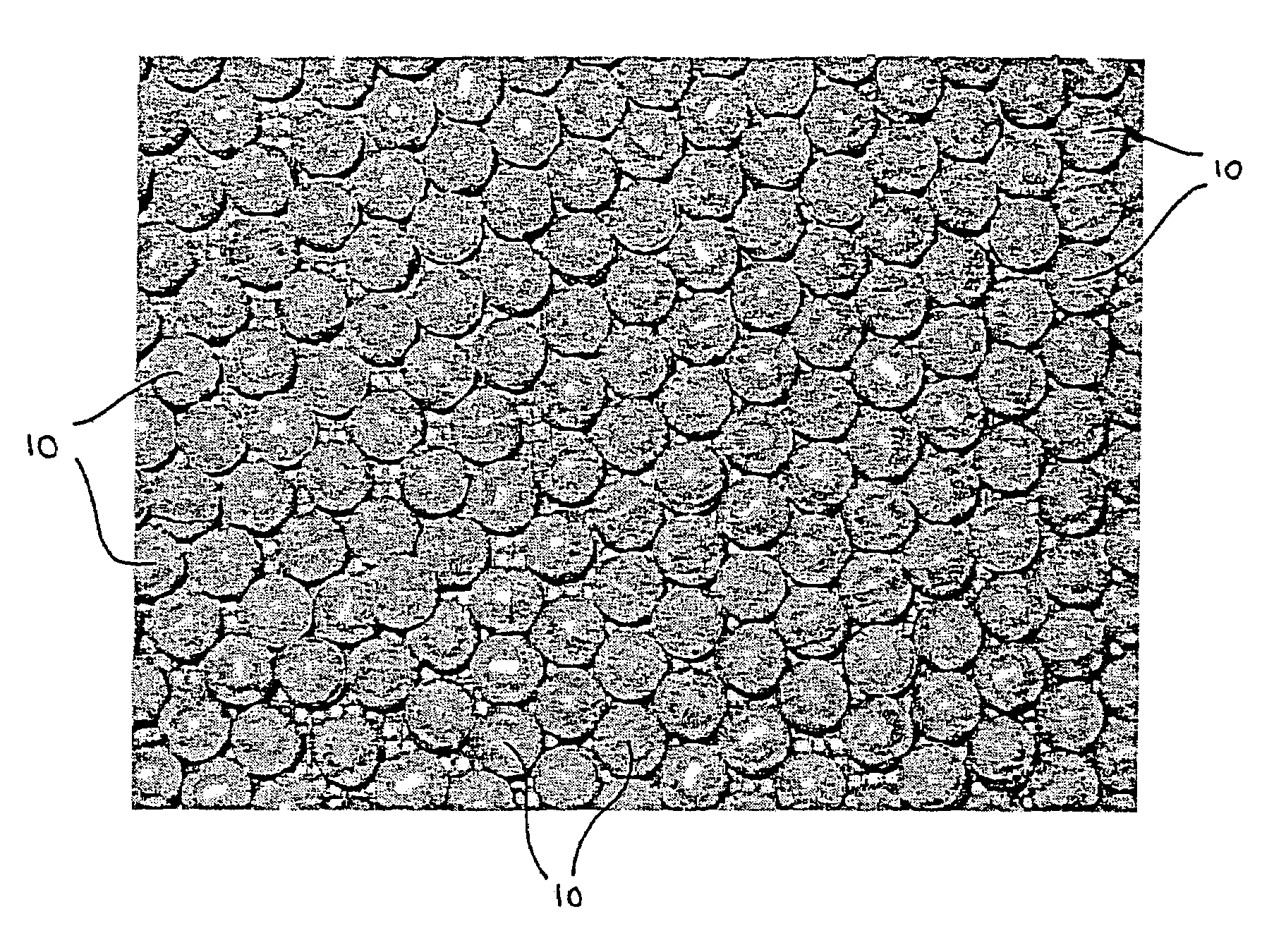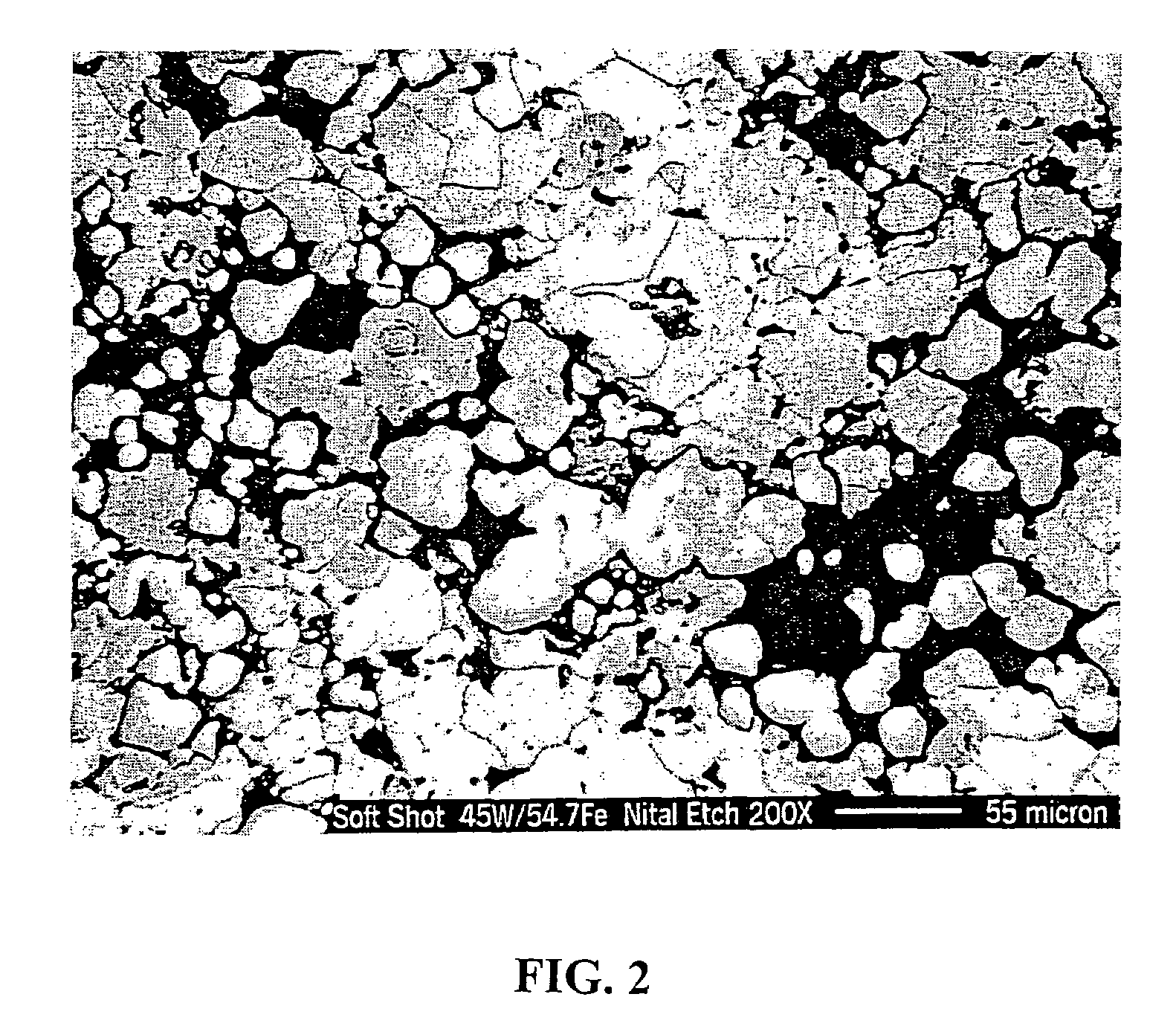Tungsten-iron projectile
a technology of projectiles and iron-based materials, applied in the field of projectile manufacturing, can solve the problems of not being able to emulate the internal ballistic, external ballistic, terminal ballistic characteristics of lead-base projectiles and shot, and not being able to adequately soft and ductile offerings in the current art, etc., to achieve high hardness, reduce hardness, and high manufacturing cost
- Summary
- Abstract
- Description
- Claims
- Application Information
AI Technical Summary
Benefits of technology
Problems solved by technology
Method used
Image
Examples
example 1
[0046]In one preferred and non-limiting embodiment of the present invention, the projectile was prepared by blending 45% Titan 24 micron tungsten powder (TW24), 54.7% A-1000-B iron powder (as supplied by ARC Metals) and 0.3% Acrawax. Five hundred pounds of this mixture was blended in a Patterson-Kelly Twin Shell “V” blender for twenty minutes. The mixture had an apparent density of 4.4 grams per cubic centimeter and a flow of 19 s / 50 g (Arnold meter). Multiple lots were tested for apparent density and flow. The results of this testing are as follows:
[0047]
LotApparent density (g / cc)Flow (s / 50 g)14.4918.524.481934.4619.5
[0048]Next, the mixture of tungsten and iron was pressed in a high-speed rotary tablet press (Stokes BB2, 33-station) using modified spherical tooling with a nominal die size of 0.187 inches. The projectiles had a nominal density of 9 grams per cubic centimeter, which was obtained by dividing the geometric volume in cubic centimeters by the weight in grams. In order to...
example 2
[0055]In this example, the projectile 10 was prepared by blending 48% Titan 24 micron tungsten powder (TW24), 51.7% A-1000-B iron powder (as supplied by ARC Metals), and 0.3% Acrawax. Ten pounds of this mixture was blended by hand in a closed plastic container by shaking and rolling the container for ten minutes.
[0056]Next, the mixture was pressed in a high-speed rotary table press (Stokes BB1, 33-station) using modified spherical tooling with a nominal die size of 0.187 inches. Pressed projectiles had a nominal density of 9.3 grams per cubic centimeter. This nominal density was determined as discussed above. In order to reduce individual measurement variations, groups of ten were collected and measured.
[0057]The compacted projectiles were loaded into a perforated steel basket and fed into a 12-inch belt furnace, as discussed above. In this example, the furnace had two zones that were set for 1500° F. (pre-heat) and 2150° F. (high-heat), and the belt speed was set for six inches per...
example 3
[0061]In this example, the projectile was prepared by blending 52% Titan 24 micron tungsten powder (TW24), 47.7% A-1000-B iron powder (as supplied by ARC Metals), and 0.3% Acrawax. Ten pounds of this mixture was blended by hand in a closed plastic container by shaking and rolling the container for ten minutes.
[0062]The mixture was compacted in a high-speed rotary tablet press as discussed above in connection with the previous examples. The pressed projectiles had a nominal density of 9.8 grams per cubic centimeter, as determined as discussed above. In order to reduce individual measurement variations, groups of ten were collected and measured.
[0063]Next, the pressed projectiles were loaded into a perforated steel basket and fed into a 12-inch belt furnace used had a protective 90:10 nitrogen-hydrogen atmosphere flowing at a total of 500 SCFH. The furnace had two zones that were set for 1500° F. (pre-heat) and 2125° F. (high-heat), and the belt speed was set for six inches per minute...
PUM
| Property | Measurement | Unit |
|---|---|---|
| size | aaaaa | aaaaa |
| diameter | aaaaa | aaaaa |
| temperature | aaaaa | aaaaa |
Abstract
Description
Claims
Application Information
 Login to View More
Login to View More - R&D
- Intellectual Property
- Life Sciences
- Materials
- Tech Scout
- Unparalleled Data Quality
- Higher Quality Content
- 60% Fewer Hallucinations
Browse by: Latest US Patents, China's latest patents, Technical Efficacy Thesaurus, Application Domain, Technology Topic, Popular Technical Reports.
© 2025 PatSnap. All rights reserved.Legal|Privacy policy|Modern Slavery Act Transparency Statement|Sitemap|About US| Contact US: help@patsnap.com



